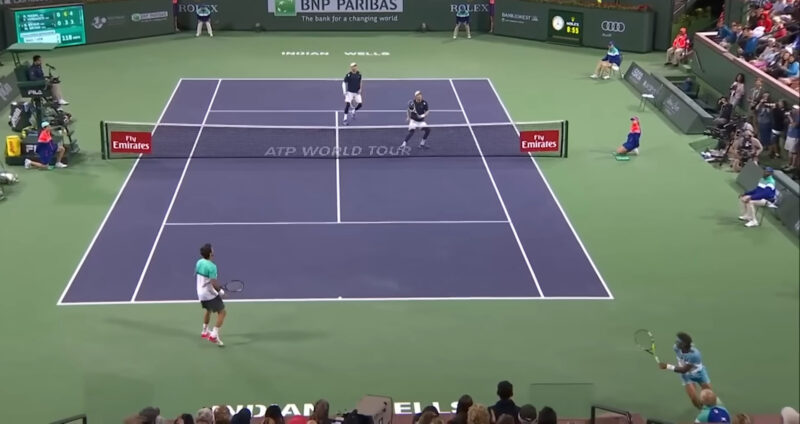Communication is vital in doubles tennis, where coordination between partners can make the difference between winning and losing.
One of the most effective ways to ensure smooth communication during a match is by using hand signals.
These signals allow partners to strategize without the need for verbal communication, helping them stay one step ahead of their opponents. After a match, you need to think about whether the communication with your partner worked.
In professional doubles matches, hand signals are commonly used and are an essential part of the game, ensuring that partners move in sync and execute their game plan efficiently.
Let us talk about the doubles hand signals in greater detail.
1. Wide Serve
A wide serve is one of the most effective tools in doubles tennis, aimed at pulling the returner far toward the sideline.
By targeting the outer edges of the service box, this serve forces the returner into a difficult defensive position, often leaving them with limited shot options and less time to react.
How the Wide Serve is Signaled

- Pinky Finger (Deuce Side): On the Deuce side (right side of the court), the net player signals a wide serve by showing their pinky finger.
- Thumb (Advantage Side): On the advantage side (left side of the court), the wide serve signal is given by showing the thumb.
Strategic Advantage of a Wide Serve
The wide serve is particularly useful when you want to:
- Stretch the Returner: By pulling the opponent wide, you reduce the angles available for their return.
- Create Space for the Next Shot: A wide serve often leaves the opposing team out of position, opening up the center of the court for a decisive shot on the next play.
- Reduce Reaction Time for the Returner: By pushing the returner wide, you force them into a hurried response, often resulting in a weaker or inaccurate return.
2. Body Serve
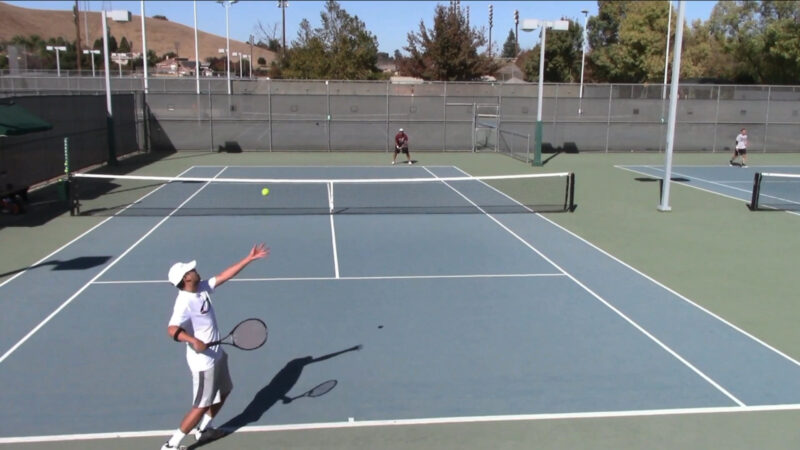
A body serve is one of the most effective tactics in doubles tennis and one of the commonest doubles hand signals.
Unlike serves that target the wide areas or the center (T), the body serve focuses directly on the returner’s body.
The Signal for a Body Serve
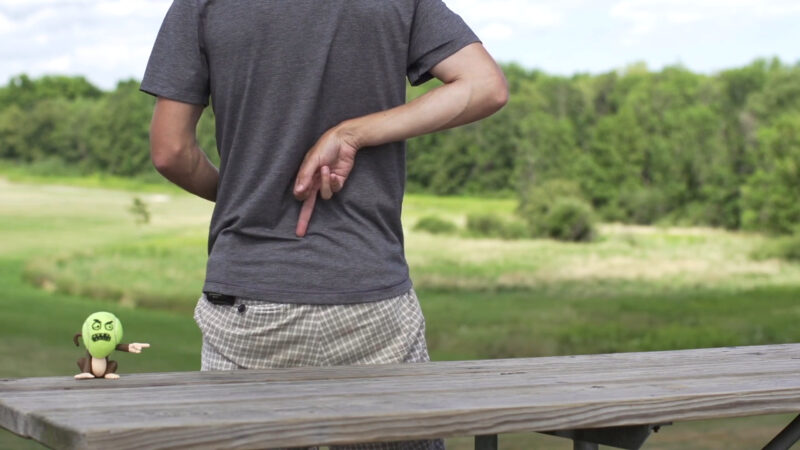
In doubles, the net player signals a body serve by holding up the middle finger. The signal is quick and subtle, allowing for smooth, non-verbal communication between partners without alerting the opposition to the game plan.
Purpose of the Body Serve
The main objective of a body serve is to jam the returner. When the ball is directed toward the body, the returner is put in a tight position, making it hard for them to step away from the ball or fully extend their arms for a strong swing.
3. T-Serve

The T-serve is a fundamental weapon in doubles tennis, where the server aims down the center of the service box, along the line where the two service boxes meet, this area is referred to as the “T.”
The T-serve is a powerful option that challenges the returner, forcing them into a quick decision and reducing the angles they can use for their return.
Signal for the T-Serve
- Deuce side: The net player signals the T-serve using the thumb.
- Advantage side: The pinky finger is used to signal a T-serve.
These hand signals ensure that the server knows exactly where to aim, helping the team maintain precision and control over the serve.
The Strategic Goal of the T-Serve
- Forcing a decision: The returner must quickly decide which side to hit from, as the serve comes directly down the middle.
- Reducing return angles: Since the ball is placed down the center, it minimizes the angles available for the returner.
Benefits of a Well-Executed T-Serve
- Weak return: A strong T-serve often leads to a weaker return. The returner, pressed for time and space, is more likely to hit a conservative shot that’s easier to handle.
- Setting up for offense: By pushing the returner into a defensive position, the serving team gains control of the rally.
4. Stay
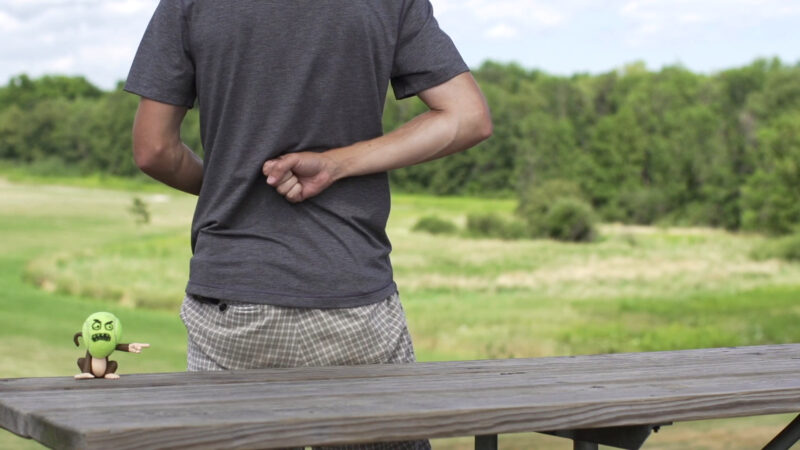
In doubles tennis, when the net player signals a closed fist, it sends a clear message: they intend to stay in position and cover the line.
The decision is crucial for ensuring that both players have clearly defined roles during the point, allowing for more effective court coverage and minimizing confusion between partners.
What the Stay Signal Communicates
The closed fist is the universal signal that the net player will remain in their current position, primarily focusing on defending the line.
The server’s responsibility shifts as a result. Since the net player is staying put, the server knows they need to be ready to cover the middle of the court, particularly cross-court returns.
Benefits of Staying at the Net
Staying in position provides several strategic advantages, especially in fast-paced rallies that demand quick reactions.
- Optimal net coverage: When the net player stays, they are ideally positioned to intercept shots aimed down the line.
- Confidence for the server: Knowing that their partner is holding the line allows the server to concentrate on their movements. The server can focus on covering the middle of the court and any cross-court returns without worrying about what their partner is doing at the net.
When to Use the Stay Signal
The stay signal is an excellent choice in several tactical situations:
- Against strong cross-court returners: If the returner has a powerful or consistent cross-court shot, the net player staying in position forces the returner to aim down the line.
- Confidence in the serve: When the server is confident in their ability to hit a serve that will limit the returner’s shot options.
- Minimizing risks: Staying is a more conservative play than poaching, which can be risky if the timing is off or the opponents read the move.
5. Poach
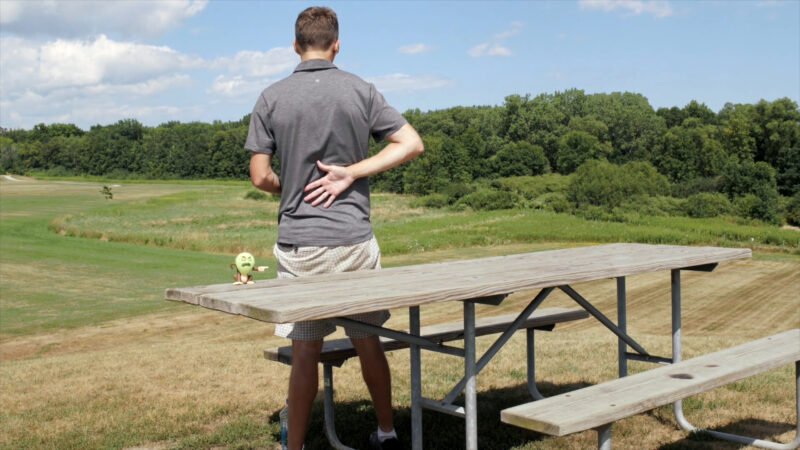
Poaching in doubles tennis is a tactic where the net player moves across the court to intercept the opponent’s return, typically one expected to go cross-court.
It’s a proactive and aggressive play, signaled by an open hand, that aims to disrupt the rhythm of the opposing team.
Why Use the Poach?
The primary goal of poaching is to interrupt the opponents’ flow. By cutting off a return they expect to hit cross-court, the poach forces the opponent to adjust quickly, often leading to rushed or weaker shots. This surprise element is what makes poaching so effective.
A well-timed poach can flip the dynamics of a point in an instant. Successfully intercepting the return allows the poacher to hit an easy volley or smash, quickly putting the serving team in an offensive position. This fast transition from defense to offense can be a game-changer.
When to Poach?
Poaching works best when the serving team has a clear sense of where the return will go.
If the serving team can predict that the opponent will hit a cross-court return, based on their positioning or tendencies, poaching becomes an excellent way to seize control of the point. Servers can help set this up by aiming their serves in a way that limits the returner’s options.
Poaching is especially effective against opponents who have a weaker or predictable return. For example, if a player consistently returns cross-court or has difficulty adjusting to different angles, a poach can capitalize on those vulnerabilities.
One of the greatest strengths of the poach is its unpredictability. When executed at the right moment, it catches the opponents off guard, leaving them with little time to react or adapt their shot. This surprise factor can lead to immediate points or force errors from the other side.
The Bottom Line
Doubles hand signals are a vital tool for any doubles tennis team looking to improve their communication and strategy.
By practicing and implementing these signals, players can enhance their teamwork, making their play more efficient and unpredictable.
With clear communication and coordinated movements, your doubles game can reach new heights of performance.

